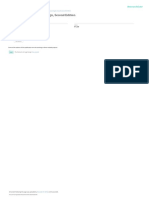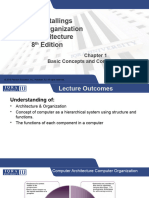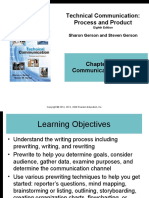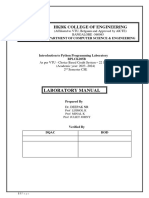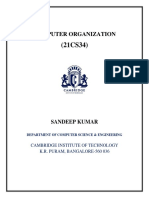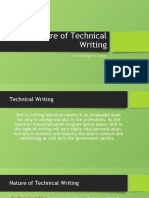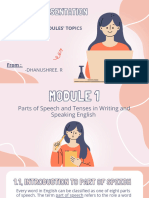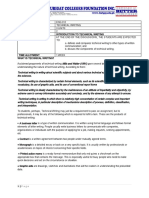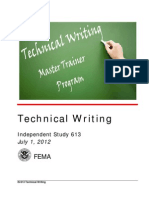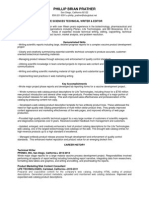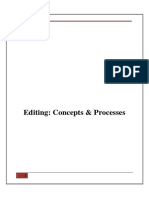Technical Report Writing Today-8th Ed.: Daniel G. Riordan and Steven E. Pauley
Technical Report Writing Today-8th Ed.: Daniel G. Riordan and Steven E. Pauley
Uploaded by
Thuan TranducCopyright:
Available Formats
Technical Report Writing Today-8th Ed.: Daniel G. Riordan and Steven E. Pauley
Technical Report Writing Today-8th Ed.: Daniel G. Riordan and Steven E. Pauley
Uploaded by
Thuan TranducOriginal Title
Copyright
Available Formats
Share this document
Did you find this document useful?
Is this content inappropriate?
Copyright:
Available Formats
Technical Report Writing Today-8th Ed.: Daniel G. Riordan and Steven E. Pauley
Technical Report Writing Today-8th Ed.: Daniel G. Riordan and Steven E. Pauley
Uploaded by
Thuan TranducCopyright:
Available Formats
IEEE TRANSACTIONS ON PROFESSIONAL COMMUNICATION, VOL. 46, NO.
1, MARCH 2003 75
Daniel G. Riordan and Steven E. Pauley
Technical Report Writing Today—8th Ed.
Book Review Index Terms—Electronic documentation, electronic research,
presentations, technical reports.
—Reviewed by
RAYMOND FLOYD,
T he book Technical Report
Writing Today is in its eighth
access the website, so one must
assume that only “authorized”
SENIOR MEMBER, IEEE students and instructors may
edition and, thus, has had obvious
check it out. It would have been
success. In “To The Instructor”
nice to be able to view the site
(pp. xix–xxv), the authors note
and see how the new chapter on
a number of changes. The most
Manuscript received September 2, 2002; website development had been
revised September 12, 2002. noteworthy include a chapter on
used in practice.
The reviewer is Vice President, developing websites (Chapter 13)
Innovative Insights, Inc., and a number of “Focus” boxes
Cody, WY 82414 USA Section I establishes foundation
concerning electronic resumes, for the remainder of the text.
(email: icubed@tritel.net).
electronic documentation, and It also presents the authors’
IEEE DOI 10.1109/TPC.2002.808341
working in groups. Having had position on effective technical
Book Publisher: the opportunity to review the writing in their statement, “the
Boston, MA: Houghton Mifflin, 2002, 7th edition [1], I welcomed the
588 pages, plus index.
ideas in the book stem from these
opportunity to review the new three concepts: technical writing
edition. is audience centered, technical
writing is presentational and
The text, a softcover book, technical writing is responsible” (p.
is divided into four topical 3). Two items worthy of mention in
sections, two appendices and Chapter 4 are two Focus sections:
the index. Section I: Technical “Bias In Language” (p. 93) and
Writing Basics consists of four “International Communication”
chapters. Section II: Technical (p. 95). Each provides insight into
Writing Techniques has seven problems that may occur with
chapters. Section III: Technical word interpretation not intended
Writing Applications has seven by the author. One area of
chapters. Section IV: Professional disappointment was the coverage
Communications contains two of ethics, specifically in recognizing
chapters. As in the 7th edition, the work of others. It appeared that
I again had some difficulty in the authors were going to cover
rationalizing the placement of the topic in a section titled “Credit
some chapters in a particular Others” (p. 15). Unfortunately,
section and will address my other than a brief statement, “Your
thoughts and recommendations obligation is to present the facts
later in this review. so that your manager understands
who conceived the idea—and
An interesting addition to the who gets the credit” (p. 15), the
8th edition was noted in the authors fail to discuss ethical
front matter (p. xxiii) with the writing, plagiarism, or copyright
introduction of a website to be infringement. Even the “Codes
used in conjunction with the of Ethical Conduct” (p. 15) fails
text. It would appear that the to include the technical writer’s
site should benefit both student responsibilities in this regard.
users of the text and instructors.
Unfortunately, there were no links It is always difficult to determine
or other information on how to where chapters fit within the
0361-1434/03$17.00 © 2003 IEEE
76 IEEE TRANSACTIONS ON PROFESSIONAL COMMUNICATION, VOL. 46, NO. 1, MARCH 2003
overall structure of a text. In this Second, information in Chapter information, informational
case, it appears to me that the 13, “Developing Websites,” should searches, technical support, and
first two chapters in Section II, have been in the last section so forth. Each type of webpage
“Researching” and “Summarizing,” (more about that section shortly). requires specific approaches that
belong in Section I, as they In the position it holds, the have to be understood and used
deal with basic concepts for the special emphasis on good website for the page to be successful. One
technical writer. The remaining development needs is lost. item of interest is the authors’
chapters provide excellent material statement that “the browser opens
for the technical writer or student, The title of Section IV, “Professional the screen indicated” (p. 324).
with special emphasis on the use Communications,” suggests that What is a browser? The word is
of color (“Focus on Color” [p. 169]) all the other discussions of not listed in the index and only
and the material on visual aids technical communication must a passing definition is offered on
given in Chapter 8. It was also good be nonprofessional. I do not page 341, when the authors note,
to see that a number of problems believe that to be the intent of the “The two major browsers are …”
pointed out in the prior edition authors; it is simply confusing. The fact that the authors know
have been corrected in Chapter 8 More importantly, I would like what a browser is does not mean
for this edition. to see Chapter 13, “Developing that every reader will.
Websites,” moved into this section,
Having provided fundamentals along with the current Chapter 20, Both appendices provide reference
to this point, in Section III the “Job Application Materials.” In the material for the technical writer
authors begin to look at specific latter case, Chapter 20 could have or student. The only thing I found
types of technical writing, i.e., been divided into two chapters, the missing was something mentioned
memorandums, informal reports, first dealing with résumés and the earlier—the link to writing
formal reports, proposals, and second dealing with cover letters, ethics, copyright, and plagiarism.
user manuals. In each case, the application letters, and follow-up Appendix B on “Documentary
authors provide insight into the letters. Sources” would have been a good
makeup of the particular report spot to include some discussion of
and, as in previous chapters, Chapter 13 is a good starting the importance of writing ethics.
provide many examples, student point for discussions on website
assignments, and worksheets to development. The impact of The 8th edition is a good upgrade
assist in the learning process. the web has been recognized from the 7th edition. Either will
From my perspective, there were around the world to the point that make a reasonable addition to the
two problems with this section. individuals are placing personal technical writer’s reference library.
First, Chapter 19, “Letters,” information on the web for friends However, if I had the 7th edition
should have been included in and family. I believe the authors already, rather than adding the 8th
this section rather than the have provided basic information edition, I would suggest investing
following one. Writing letters, both but have not addressed the in a technical text on webpage
formal and informal, is another differing needs in webpages, development as a supplement to
technical writing application. i.e., personal, sales, technical the information in Chapter 13.
REFERENCES
[1] R. E Floyd, “Review of Technical Report Writing Today, 7th Edition,”
IEEE Trans. Prof. Commun., vol. 43, no. 3, pp. 339–340, 2000.
You might also like
- (Ebook PDF) A Guide To Writing As An Engineer, 4th Edition All Chapters Instant DownloadDocument41 pages(Ebook PDF) A Guide To Writing As An Engineer, 4th Edition All Chapters Instant Downloadnpssjrina100% (4)
- The Elements of Graphic Design, Second Edition: Alexander W. WhiteDocument11 pagesThe Elements of Graphic Design, Second Edition: Alexander W. WhiteJohn Carlo Layug100% (1)
- Lecture 1 Introduction To Computer Architecture and OrganizationDocument69 pagesLecture 1 Introduction To Computer Architecture and Organizationsyed.12682No ratings yet
- User and Task Analysis For Interface Design PDFDocument2 pagesUser and Task Analysis For Interface Design PDFGaganNo ratings yet
- MP Toppers SolutionDocument98 pagesMP Toppers SolutionJVM oceanNo ratings yet
- Functions of Technical WritingDocument6 pagesFunctions of Technical Writingoanne_0867% (3)
- Technical WritingDocument12 pagesTechnical Writingzahur27No ratings yet
- Unit II - IIIDocument28 pagesUnit II - IIISteffiNo ratings yet
- Computational Methods Lab Manual - 230926 - 094757Document28 pagesComputational Methods Lab Manual - 230926 - 094757luthrasakshammNo ratings yet
- Question Bank 7th Sem CS 701Document6 pagesQuestion Bank 7th Sem CS 701Jeetu SinghNo ratings yet
- Computer Organisation and Architectre NotesDocument353 pagesComputer Organisation and Architectre NotesvardhinNo ratings yet
- Lab Manual-ArtificialDocument26 pagesLab Manual-ArtificialYadav AshishNo ratings yet
- DBMS LAB Manual IareDocument10 pagesDBMS LAB Manual IareSrinivas KanakalaNo ratings yet
- Presentations PPT Unit-3 25042019031301AMDocument58 pagesPresentations PPT Unit-3 25042019031301AMAwaneesh RajNo ratings yet
- Dbms by Bipin C Desai PDFDocument3 pagesDbms by Bipin C Desai PDFSaurabh Raut0% (1)
- Emplobillity SkillsDocument121 pagesEmplobillity SkillsMannam Sarath Sarath100% (2)
- DSA by Love BabbarDocument165 pagesDSA by Love BabbarSamsung Tablet100% (1)
- (CSE) Computer Science Engineering Multiple Choice Questions Answers PDFDocument9 pages(CSE) Computer Science Engineering Multiple Choice Questions Answers PDFHanif AnjumNo ratings yet
- CS 19 GATE PSUs PDFDocument2 pagesCS 19 GATE PSUs PDFAmit koulNo ratings yet
- 3 - Disk Performance ParameterDocument5 pages3 - Disk Performance Parametersaurabmi2No ratings yet
- Technical Communication: Process and Product: Sharon Gerson and Steven GersonDocument19 pagesTechnical Communication: Process and Product: Sharon Gerson and Steven Gersonramsha razaNo ratings yet
- Nsic - (Ipt-Internship 2021-2022)Document2 pagesNsic - (Ipt-Internship 2021-2022)Shayan HoreNo ratings yet
- Tier 1 Ece-Sona College of Technology PDFDocument698 pagesTier 1 Ece-Sona College of Technology PDFPrasanth Varasala100% (2)
- 3.operating Systems Lab 1Document69 pages3.operating Systems Lab 1Vive Kowsal Yaniss100% (1)
- 18CS36 DMS Module 1 Notes PDFDocument63 pages18CS36 DMS Module 1 Notes PDFLavanya92% (13)
- Verbal Ability Placement PaperDocument33 pagesVerbal Ability Placement Paperkrithikgokul selvamNo ratings yet
- CS3301 Data Structures Nov Dec 2022 Question Paper DownloadDocument3 pagesCS3301 Data Structures Nov Dec 2022 Question Paper Downloadlathikavenkat720100% (1)
- FORMAT FOR 6th SEMESTER BTECH SYNOPSISDocument4 pagesFORMAT FOR 6th SEMESTER BTECH SYNOPSISMahima DewanganNo ratings yet
- Mc4103 Python Programing Question PaperDocument4 pagesMc4103 Python Programing Question Papersaishan3003No ratings yet
- Ex No: 6 Raw Sockets (Packet Capturing & Filtering)Document6 pagesEx No: 6 Raw Sockets (Packet Capturing & Filtering)Pitchairaj BhuvaneswariNo ratings yet
- III Sem (CA) RDBMS Lab Qoestion Bank 2019-20Document5 pagesIII Sem (CA) RDBMS Lab Qoestion Bank 2019-20MAJA YAHI HAINo ratings yet
- Course Committee FormatDocument3 pagesCourse Committee Formatabsalnabi100% (1)
- EC8095-VLSI Design - 01 - by WWW - LearnEngineering.inDocument134 pagesEC8095-VLSI Design - 01 - by WWW - LearnEngineering.inDelphin ShibinNo ratings yet
- Cs8251 Lesson PlanDocument2 pagesCs8251 Lesson Planshajitha120450% (2)
- Unit-7: Iot SecurityDocument21 pagesUnit-7: Iot SecuritySAMPANo ratings yet
- CHS Practical FileDocument40 pagesCHS Practical Fileshaktisinghdr7060No ratings yet
- Compiler Design Handwritten NotesDocument93 pagesCompiler Design Handwritten NotesAdityaNo ratings yet
- Daa Notes CompleteDocument203 pagesDaa Notes CompleteadiityachandNo ratings yet
- Quantum Design and Analysis of Algorithms Full PDFDocument196 pagesQuantum Design and Analysis of Algorithms Full PDFmantasha18110No ratings yet
- VCD Remuneration For Examination WorkDocument12 pagesVCD Remuneration For Examination WorkAvani ShahNo ratings yet
- Question Bank Bachelor of Computer Application (BCA-11) BCA Fifth Semester BCA-18 E-Commerce Section-A (Long Answer Type Questions)Document4 pagesQuestion Bank Bachelor of Computer Application (BCA-11) BCA Fifth Semester BCA-18 E-Commerce Section-A (Long Answer Type Questions)priyankaNo ratings yet
- Daa-r22-Unit 1&2-Digital Notes Cse Dept (A.y 2024-25) @DR.KDocument50 pagesDaa-r22-Unit 1&2-Digital Notes Cse Dept (A.y 2024-25) @DR.KHasi PNo ratings yet
- Unix Programming For BE VTU Cou - I. A. DhotreDocument292 pagesUnix Programming For BE VTU Cou - I. A. DhotreDavid LazarNo ratings yet
- BPLCK205B Manual (23-24)Document25 pagesBPLCK205B Manual (23-24)deeptikantapanigrahi45No ratings yet
- Computer Organization: Sandeep KumarDocument117 pagesComputer Organization: Sandeep KumarGaurav NNo ratings yet
- ANFISDocument42 pagesANFISEzequiel PezoNo ratings yet
- Bihar STET Previous Year Question Paper 2 Computer Science Shift 1 1Document35 pagesBihar STET Previous Year Question Paper 2 Computer Science Shift 1 1riteshlock10% (1)
- Tech Mahindra Exam Pattern 2024Document13 pagesTech Mahindra Exam Pattern 2024rahul545438No ratings yet
- Understanding Oop With Java by Timothy BuddDocument20 pagesUnderstanding Oop With Java by Timothy Buddsaleem0100% (5)
- complete-reference-vb_net_79Document1 pagecomplete-reference-vb_net_79khalidNo ratings yet
- 08 Zender Early FINALDocument24 pages08 Zender Early FINALPraveen nairNo ratings yet
- The Human-Computer Interaction Handbook FundamentalDocument4 pagesThe Human-Computer Interaction Handbook FundamentalRogen Darell AbanNo ratings yet
- Portfolio Reflection Asessment TemplateDocument10 pagesPortfolio Reflection Asessment TemplateilankoonjanithaNo ratings yet
- 22CSE53 Full Stack FinalDocument4 pages22CSE53 Full Stack FinalVarsha HNo ratings yet
- 2.technical Writing in The Corporate World - (Section 3 Editing The Technical Document)Document12 pages2.technical Writing in The Corporate World - (Section 3 Editing The Technical Document)Andrea GarciaNo ratings yet
- TW ElementsDocument2 pagesTW Elementstin del rosarioNo ratings yet
- 5355 CS3023 (Hci)Document6 pages5355 CS3023 (Hci)Sukhchain Singh ChheenaNo ratings yet
- Download full (eBook PDF) Technical Communication A Practical Approach 8th Edition ebook all chaptersDocument56 pagesDownload full (eBook PDF) Technical Communication A Practical Approach 8th Edition ebook all chaptersseibtknupp7eNo ratings yet
- Architecture's New Media: Principles, Theories and Methods of Computer-Aided DesignDocument3 pagesArchitecture's New Media: Principles, Theories and Methods of Computer-Aided DesignDouglas Lopes de SouzaNo ratings yet
- Nectar: A Browser-Agnostic Contextual Web Annotation Tool: Daniel S. Crosta December 14, 2005Document8 pagesNectar: A Browser-Agnostic Contextual Web Annotation Tool: Daniel S. Crosta December 14, 2005postscriptNo ratings yet
- Proposal - Development of An AI-Enhanced Online Book Reading System With Automatic Summarization and Audio ConversionDocument8 pagesProposal - Development of An AI-Enhanced Online Book Reading System With Automatic Summarization and Audio Conversion22560023No ratings yet
- S24 TRW Summative CourseworkDocument12 pagesS24 TRW Summative Courseworkabd.sh022No ratings yet
- Guidelines For Producing Effective DocumentationDocument4 pagesGuidelines For Producing Effective DocumentationJitendra Sharma100% (1)
- Technical Writing CoursesDocument4 pagesTechnical Writing CoursesMr. PainNo ratings yet
- Learning Business Writing BasicsDocument18 pagesLearning Business Writing BasicsTravis DorsoNo ratings yet
- Nature of Technical WritingDocument18 pagesNature of Technical Writingrara1No ratings yet
- Englishpptci 019Document65 pagesEnglishpptci 019who knowsNo ratings yet
- ENG 312 MODULE 2 MajorDocument5 pagesENG 312 MODULE 2 MajorReydar DevarraNo ratings yet
- Purcom 5Document4 pagesPurcom 5vincekempis03No ratings yet
- Technical and Literary WritingDocument1 pageTechnical and Literary WritingDaisylineCaleonCruzNo ratings yet
- EPLC User Manual Practices GuideDocument2 pagesEPLC User Manual Practices GuideHussain ElarabiNo ratings yet
- Is 613TechnicalWritingDocument129 pagesIs 613TechnicalWritingShem David Beltran100% (2)
- Final Exam Technical WritingDocument3 pagesFinal Exam Technical WritingReñer Aquino Bystander100% (1)
- English Core 2005Document5 pagesEnglish Core 2005thiripura sundariNo ratings yet
- Eeng 222Document16 pagesEeng 222Mackdonald ShiwaniNo ratings yet
- Chap 1Document13 pagesChap 1Jonson PalmaresNo ratings yet
- Life Sciences Technical Writer Editor in San Diego CA Resume Phillip PratherDocument2 pagesLife Sciences Technical Writer Editor in San Diego CA Resume Phillip PratherPhillipPratherNo ratings yet
- Technical Report WritingDocument7 pagesTechnical Report Writingapi-26373879No ratings yet
- Eng122 Compiled HandoutDocument13 pagesEng122 Compiled HandoutALL ABOUT PAGEANTARYNo ratings yet
- Engl031 ReviewerDocument11 pagesEngl031 ReviewerNaneth SabangNo ratings yet
- Technical WritingDocument4 pagesTechnical WritingFrances Mae GerpacioNo ratings yet
- Unit 6 Documenting SourcesDocument13 pagesUnit 6 Documenting SourcesSkuy LivingNo ratings yet
- John Teneyck Resume 2017Document2 pagesJohn Teneyck Resume 2017api-306997047No ratings yet
- Technical ReportDocument3 pagesTechnical ReportMarielleyNo ratings yet
- 105 Editing Concept ProcessDocument103 pages105 Editing Concept ProcessHanjala GalibNo ratings yet
- BTW Lesson 1 and 2Document13 pagesBTW Lesson 1 and 2Godwin MarceñoNo ratings yet
- Uge2 Week1 3Document20 pagesUge2 Week1 3Sunshine PalwaNo ratings yet
- Information Technology Department: Technical Documentation For ItDocument4 pagesInformation Technology Department: Technical Documentation For ItMark Camo Delos SantosNo ratings yet
- Tech Writing GradDocument6 pagesTech Writing GradWill KurlinkusNo ratings yet
- Chapter 1Document7 pagesChapter 1Raphael SamsonNo ratings yet

